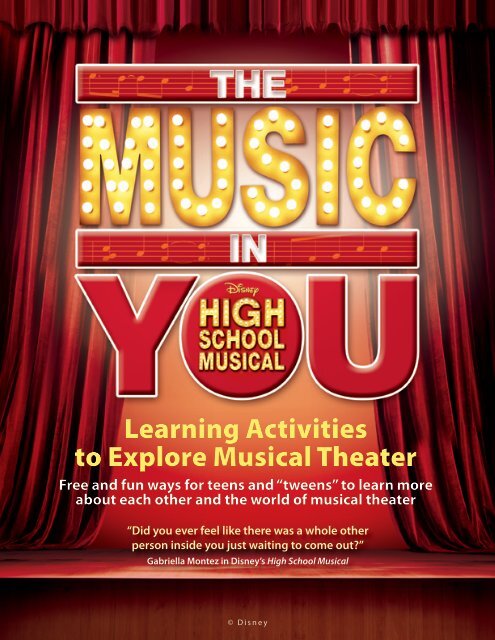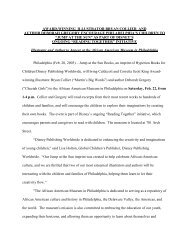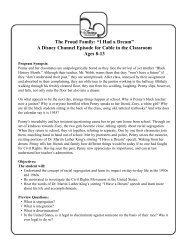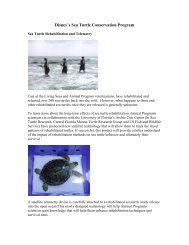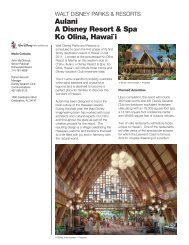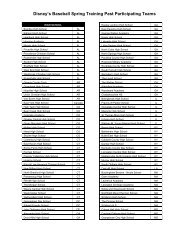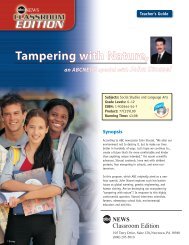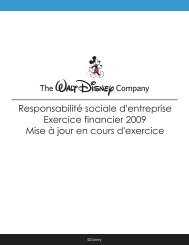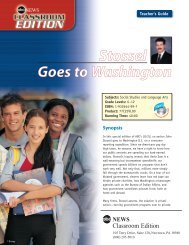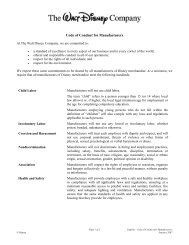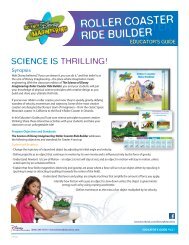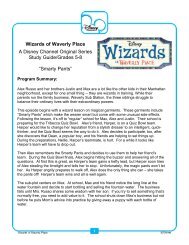Learning Activities to Explore Musical Theater ... - Disney Channel
Learning Activities to Explore Musical Theater ... - Disney Channel
Learning Activities to Explore Musical Theater ... - Disney Channel
You also want an ePaper? Increase the reach of your titles
YUMPU automatically turns print PDFs into web optimized ePapers that Google loves.
<strong>Learning</strong> <strong>Activities</strong><br />
<strong>to</strong> <strong>Explore</strong> <strong>Musical</strong> <strong>Theater</strong><br />
Free and fun ways for teens and “tweens” <strong>to</strong> learn more<br />
about each other and the world of musical theater<br />
“Did you ever feel like there was a whole other<br />
person inside you just waiting <strong>to</strong> come out?”<br />
Gabriella Montez in <strong>Disney</strong>’s High School <strong>Musical</strong><br />
© <strong>Disney</strong><br />
The Music in You • <strong>Learning</strong> <strong>Activities</strong> <strong>to</strong> <strong>Explore</strong> <strong>Musical</strong> <strong>Theater</strong> • D i s n e y C h a n n e l . c o m / H i g h S c h o o l M u s i c a l / M u s i c I n Yo u<br />
Page 1
P R E L U D E :<br />
EVERYONE HAS DREAMS<br />
Some dream of fortune and fame.<br />
Others dream of a serious vacation<br />
from school. Some want <strong>to</strong> be <strong>to</strong>p<br />
athletes or win scholastic honors,<br />
while others hope <strong>to</strong> star in the<br />
school play and make friends. What<br />
if you want it all? How can you<br />
break free of expectations and start<br />
something new?<br />
In <strong>Disney</strong>’s High School <strong>Musical</strong>, teens discover<br />
it is possible <strong>to</strong> reach even the <strong>to</strong>ughest goals<br />
when you believe in yourself, pursue your<br />
passions and work <strong>to</strong>gether. The students at<br />
East High have <strong>to</strong> deal with cliques and all<br />
kinds of unwritten “rules” about their roles as<br />
they explore new interests, build relationships<br />
and struggle <strong>to</strong> find out just who they really<br />
are. Sound familiar? Beyond the show’s<br />
catchy songs, cool costumes and the typical<br />
high school dramas, <strong>Disney</strong>’s High School<br />
<strong>Musical</strong> features character and s<strong>to</strong>ries <strong>to</strong> which<br />
everyone can relate.<br />
Learn the lingo!<br />
Sound like a pro as you master<br />
new words from musical theater<br />
throughout the guide:<br />
A prelude is a short bit<br />
of instrumental music that sets<br />
the mood for the following act.<br />
“When we reach, we can fly.”<br />
Whether you dream of being a player or<br />
playmaker, a singer or songwriter, a star<br />
performer on stage or the many other theaters<br />
of life—try activities in this guide <strong>to</strong> help<br />
bring out the music in you. Along the way,<br />
you will discover the joys of theater and learn<br />
more about yourself, your family and friends!<br />
“Bop <strong>to</strong> the Top!”<br />
Songs and singing are featured throughout<br />
<strong>Disney</strong>’s High School <strong>Musical</strong>—karaoke, pep<br />
rally cheers, audition duets and, in the musical<br />
theater tradition, when characters break in<strong>to</strong><br />
song while speaking. Ultimately, High School<br />
<strong>Musical</strong> is part of a great musical theater<br />
tradition, a distinctly American invention,<br />
ready for you <strong>to</strong> explore.<br />
The Music in You • <strong>Learning</strong> <strong>Activities</strong> <strong>to</strong> <strong>Explore</strong> <strong>Musical</strong> <strong>Theater</strong> • D i s n e y C h a n n e l . c o m / H i g h S c h o o l M u s i c a l / M u s i c I n Yo u<br />
Page 2
CUE SHEET<br />
Prelude: Everyone Has Dreams Page 2<br />
Before the Curtain Rises: Welcome <strong>to</strong> Our Show! Page 4<br />
Introduction <strong>to</strong> <strong>Musical</strong> <strong>Theater</strong> Page 4<br />
Meet the Cast! Page 6<br />
Overture: Get’cha Head in the Game Page 7<br />
“We’re All in This Together” Page 7<br />
“The World Can See Us in a Way<br />
That’s Different Than Who We Are” Page 9<br />
“All the World’s a Stage” Page 10<br />
Act 1: The Ac<strong>to</strong>r’s Craft Page 12<br />
Act 2: Writing and Directing Page 14<br />
Intermission: Take a Break Page 16<br />
Act 3: When Words Meet Music Page 17<br />
Act 4: S<strong>to</strong>ries in Motion Page 19<br />
Behind the Scenes: Production and Promotions Page 21<br />
Grand Finale: Your Own High School <strong>Musical</strong> Page 23<br />
Direc<strong>to</strong>r’s Notes Page 25<br />
“Check, check…testing…one, two, three.…”<br />
The tech crew and stage manager run<br />
lighting, sound and safety checks before<br />
every show. Before the curtain rises on<br />
your activities, always get the “all clear”<br />
signal from your stage manager—Mom,<br />
Dad or another responsible adult!<br />
In theater and film, a cue is a<br />
stage signal or direction that<br />
tells the cast and crew where <strong>to</strong><br />
go or what action <strong>to</strong> take.<br />
In the recording industry, cue<br />
sheets spell out the order of<br />
tracks on a compact disc.<br />
The Music in You • <strong>Learning</strong> <strong>Activities</strong> <strong>to</strong> <strong>Explore</strong> <strong>Musical</strong> <strong>Theater</strong> • D i s n e y C h a n n e l . c o m / H i g h S c h o o l M u s i c a l / M u s i c I n Yo u<br />
Page 3
B E F O R E T H E C U R T A I N R I S E S :<br />
WELCOME TO OUR SHOW!<br />
Introduction <strong>to</strong> <strong>Musical</strong> <strong>Theater</strong><br />
“Now that’s show biz.”<br />
Ms. Darbus, the drama teacher in <strong>Disney</strong>’s<br />
High School <strong>Musical</strong>, wants students <strong>to</strong><br />
appreciate the wonder, tradition and his<strong>to</strong>ry<br />
of musical theater. Like jazz and the blues,<br />
musical theater is a unique American form<br />
of art, rooted in older cultures. Born in the<br />
Jazz Age of the 1920s, musical theater blends<br />
operas, operettas, musical and dance revues<br />
and vaudeville comedy acts with popular ideas<br />
and sounds. Composers in New York City’s<br />
Tin Pan Alley cranked out crowd-pleasing<br />
musicals for the Broadway stage and recorded<br />
songs that filled the airwaves for years.<br />
• What comes <strong>to</strong> mind when someone says<br />
“musicals”? Singing? Rock opera? Music<br />
video? MP3s?<br />
• Go on a library or Internet scavenger hunt<br />
<strong>to</strong> sample the sounds of musical theater<br />
over the decades, looking for the <strong>to</strong>p<br />
songs, famous artists and hit shows in<br />
each period.<br />
• Learn more about musicals by interviewing<br />
older friends and family members. What<br />
are their favorite shows, stars, songs, scenes<br />
or composers—and why? Learn a hit show<br />
tune or dance made popular during another<br />
era of musical theater. How do s<strong>to</strong>ries, music<br />
and dance in modern musicals compare with<br />
past favorites?<br />
The sound of music.<br />
In the early days of musical theater,<br />
performers would break in<strong>to</strong> spectacular<br />
song and dance routines that had little <strong>to</strong> do<br />
with the plot. (Talk about show-s<strong>to</strong>pping<br />
scenes!) But in 1943, Richard Rodgers and<br />
Oscar Hammerstein II sparked a revolution<br />
by using song and dance <strong>to</strong> actually tell a<br />
s<strong>to</strong>ry in Oklahoma! The pair created a series<br />
of sentimental musicals with memorable<br />
songs people still love <strong>to</strong>day because, as<br />
Hammerstein once said, “the things we are<br />
sentimental about are the fundamental things<br />
in life.” What is fundamentally important<br />
<strong>to</strong> you? In their show The Sound of Music,<br />
children learn <strong>to</strong> chase away fear singing about<br />
favorite things. How does music ease your<br />
fears?<br />
“The world is filled with troubles and many<br />
injustices. But reality is as beautiful as it is ugly.<br />
I think it is just as important <strong>to</strong> sing about<br />
beautiful mornings as it is <strong>to</strong> talk about slums.<br />
I just couldn’t write anything without hope in it.”<br />
Oscar Hammerstein II (1895-1960)<br />
Broadway lyricist<br />
The Music in You • <strong>Learning</strong> <strong>Activities</strong> <strong>to</strong> <strong>Explore</strong> <strong>Musical</strong> <strong>Theater</strong> • D i s n e y C h a n n e l . c o m / H i g h S c h o o l M u s i c a l / M u s i c I n Yo u<br />
Page 4
Match the playmakers<br />
<strong>to</strong> their musicals. Check<br />
the Web for answers and<br />
learn more about these<br />
creative collabora<strong>to</strong>rs.<br />
What contributions do<br />
composers and lyricists<br />
make <strong>to</strong> a show?<br />
DYNAMIC DUOS<br />
Andrew Lloyd Webber and Tim Rice Tommy<br />
Pete Townshend and Des McAnuff The King and I<br />
Alan Menken and Howard Ashman Jesus Christ Superstar<br />
Frederick Loewe and Alan Lerner High School <strong>Musical</strong><br />
Jim Jacobs and Warren Casey West Side S<strong>to</strong>ry<br />
Richard Rodgers and Oscar Hammerstein II Grease<br />
David Lawrence and Matthew Gerrard Little Shop of Horrors<br />
Leonard Bernstein and Stephen Sondheim My Fair Lady<br />
Timeless tales.<br />
In the 1590s, William Shakespeare wrote<br />
Romeo and Juliet about the untimely death of<br />
two teens from rival households who fall in<br />
love. In 1957, audiences wept <strong>to</strong> a similar tale<br />
when West Side S<strong>to</strong>ry opened on Broadway—a<br />
show that broke from the tradition of comedy<br />
in musical theater with themes of gang<br />
violence, murder and forbidden love. Check<br />
out a few of the video or DVD versions of<br />
these plays. How do they compare? How do<br />
music and dance tell the s<strong>to</strong>ry? In <strong>Disney</strong>’s<br />
High School <strong>Musical</strong>, Kelsi writes the score<br />
for a new play called “Juliet and Romeo”—a<br />
feminist twist on Shakespeare’s classic. In<br />
trying out for the show, Troy and Gabriella<br />
rise above cliques and expectations <strong>to</strong> find joy<br />
in music and each other. What other plays<br />
feature star-crossed lovers?<br />
“You need three things in theater—<br />
the play, the ac<strong>to</strong>rs and the audience—<br />
and each must give something.”<br />
Kenneth Haigh (born 1931)<br />
British ac<strong>to</strong>r<br />
<strong>Theater</strong> etiquette.<br />
How is watching live theater different than<br />
watching a movie or TV musical? Why is<br />
it important <strong>to</strong> watch quietly? When can<br />
members of the audience make noise? What<br />
sounds are OK <strong>to</strong> make? How do you show<br />
appreciation or dissatisfaction in a theater?<br />
Wait a minute…<br />
Check out these dual definitions of words<br />
common in musical theater!<br />
Hook<br />
Score<br />
Beat<br />
Strike<br />
Block<br />
Pit<br />
Apron<br />
Wrap<br />
Corpse<br />
Beginners<br />
A phrase of music or lyrics in a song that catches<br />
audience interest, or an item you hang your coat on.<br />
All the songs in a musical—like how the points<br />
add up in a game.<br />
Hold your temper. In music and dance, a beat is<br />
a count of about one second.<br />
Three and you’re out! Or, call it quits when you<br />
take the set apart after a show.<br />
To lay out all the moves telling ac<strong>to</strong>rs where <strong>to</strong><br />
go on stage—or deflect a shot in basketball.<br />
Where the orchestra sits—lower than the<br />
stage, but not really a hole!<br />
Part of the stage in front of the curtain—and a<br />
way <strong>to</strong> stay clean in the kitchen.<br />
Grandma calls her sweater a wrap, but in theater<br />
and film, “That’s a wrap!” means it’s all over.<br />
A dead body—and when an ac<strong>to</strong>r gets an<br />
uncontrollable fit of laughter on stage!<br />
Freshmen! And cast members who are on stage<br />
when the curtain goes up.<br />
The Music in You • <strong>Learning</strong> <strong>Activities</strong> <strong>to</strong> <strong>Explore</strong> <strong>Musical</strong> <strong>Theater</strong> • D i s n e y C h a n n e l . c o m / H i g h S c h o o l M u s i c a l / M u s i c I n Yo u<br />
Page 5
Meet the Cast!<br />
Troy Bol<strong>to</strong>n is captain<br />
of the East High<br />
Wildcats basketball<br />
team—and the coach’s<br />
son. Once he meets<br />
Gabriella and sings a<br />
karaoke duet with her,<br />
he finds there’s more <strong>to</strong><br />
life than basketball.<br />
Gabriella Montez<br />
is the new girl at<br />
East High School—<br />
interested in Troy,<br />
mathematics, science<br />
and auditioning for the<br />
musical.<br />
Chad Danforth is<br />
Troy’s buddy and<br />
teammate. He loves<br />
basketball, is skeptical<br />
about leotards and<br />
gets a serious crush on<br />
Taylor when they work<br />
<strong>to</strong>gether <strong>to</strong> help their<br />
friends.<br />
PLUS:<br />
Sharpay Evans is the<br />
president of East High’s<br />
Drama Club. She’s<br />
used <strong>to</strong> getting her<br />
way—and all the lead<br />
roles.<br />
Zeke Baylor is a <strong>to</strong>p basketball player<br />
on the East High Wildcats team. We<br />
discover he has two secrets—a crush on<br />
Sharpay and a love of baking.<br />
Kelsi Nielson is a quiet, dedicated<br />
lyricist and composer working on a new<br />
feminist school musical, called “Juliet<br />
and Romeo.”<br />
Ms. Darbus is East High’s “dramatic”<br />
drama teacher. She loves introducing<br />
students <strong>to</strong> the magic of the arts, and<br />
fights with Coach Bol<strong>to</strong>n over the<br />
importance of theater and sports.<br />
Coach Bol<strong>to</strong>n is Troy’s father and<br />
basketball coach. A former Wildcats<br />
champion, he has high hopes for his<br />
team and even higher expectations for<br />
his star son.<br />
Ryan Evans is<br />
Sharpay’s sidekick<br />
and younger twin (by<br />
eight minutes—a fact<br />
Sharpay won’t let him<br />
forget!). He has starred<br />
opposite Sharpay in 17<br />
productions. And he<br />
loves hats.<br />
Taylor McKessie<br />
lives for science,<br />
thinks sports are for<br />
“Cro-magnums” and<br />
hopes that her new<br />
friend Gabriella will<br />
join the science team<br />
<strong>to</strong> help them win the<br />
Scholastic Decathlon.<br />
Say what? Write a line each character might speak or think.<br />
What slang might the character use?<br />
Sing what? What music might the character like? What karaoke<br />
song would he or she sing first?<br />
Walk this way. Move like the character. How would you enter<br />
the cafeteria on the first day?<br />
Casting direc<strong>to</strong>r. In the musical of life, who would you choose<br />
<strong>to</strong> play you? A famous ac<strong>to</strong>r, friend, teacher or men<strong>to</strong>r? Who<br />
would play the other important roles in your life s<strong>to</strong>ry?<br />
<strong>Musical</strong> direc<strong>to</strong>r. If you had <strong>to</strong> choose one song <strong>to</strong> summarize<br />
your life, what would it be?<br />
Watch High School <strong>Musical</strong> on <strong>Disney</strong> <strong>Channel</strong>!<br />
The Music in You • <strong>Learning</strong> <strong>Activities</strong> <strong>to</strong> <strong>Explore</strong> <strong>Musical</strong> <strong>Theater</strong> • D i s n e y C h a n n e l . c o m / H i g h S c h o o l M u s i c a l / M u s i c I n Yo u<br />
Page 6
What is it about musicals that brings people<br />
<strong>to</strong>gether? Get your head in<strong>to</strong> the game as you<br />
explore some of the big ideas, or themes, in<br />
<strong>Disney</strong>’s High School <strong>Musical</strong>. At the same<br />
time, get a hands-on introduction <strong>to</strong> theater<br />
techniques that even Coach Bol<strong>to</strong>n and the<br />
Wildcats would enjoy.<br />
Teamwork is the key <strong>to</strong> success in theater,<br />
sports and life. Every role is a vital part of a<br />
show’s success. Working in an ensemble is<br />
essential on stage and in life—whether in a<br />
lead, cameo, supporting, walk-on or behindthe-scenes<br />
role. And every operation needs<br />
understudies ready <strong>to</strong> step in when a player<br />
can’t perform. Consider how you work with<br />
back up, how you follow or lead and help<br />
others <strong>to</strong> shine. These are true star qualities.<br />
O v e r t u r e :<br />
GET’CHA HEAD IN THE GAME<br />
“We’re All in This Together!”<br />
An overture is a piece<br />
of music that sets the<br />
mood and introduces the<br />
audience <strong>to</strong> themes they<br />
will hear throughout the<br />
show.<br />
Beautiful noise.<br />
Gather in a circle,<br />
with each person<br />
bringing a small<br />
object <strong>to</strong> make<br />
a rhythmic noise. Listen as the first flips<br />
through pages of a book, another rattles keys,<br />
still another dribbles a ball—all playing with<br />
sound, <strong>to</strong>ne, cadence and beat. Moving in<br />
turn around the circle, each person adds <strong>to</strong><br />
the groove—exploring their own sound while<br />
composing a song in harmony with others.<br />
After jamming for awhile, play without<br />
props. Each player creates a sound—chirping,<br />
clicking, clapping, tapping, experimenting<br />
with high and low, swift and slow—as others<br />
join in one at a time around the circle.<br />
Next, ask each person <strong>to</strong> move <strong>to</strong> the music,<br />
building off the movements of others.<br />
“Okay, now we will only be able<br />
<strong>to</strong> do this if we all work <strong>to</strong>gether.”<br />
Troy Bol<strong>to</strong>n in <strong>Disney</strong>’s High School <strong>Musical</strong><br />
Mix and mingle interviews.<br />
Mix and mingle interviews can help you focus<br />
and listen better. Ask players in a group <strong>to</strong><br />
move freely around the room as you sample a<br />
track from <strong>Disney</strong>’s High School <strong>Musical</strong>. Pause<br />
the music. Players partner with the closest<br />
person, standing back <strong>to</strong> back. One partner<br />
interviews the other, then retells the s<strong>to</strong>ry <strong>to</strong><br />
the group. Switch roles so each person gets<br />
The Music in You • <strong>Learning</strong> <strong>Activities</strong> <strong>to</strong> <strong>Explore</strong> <strong>Musical</strong> <strong>Theater</strong> • D i s n e y C h a n n e l . c o m / H i g h S c h o o l M u s i c a l / M u s i c I n Yo u<br />
Page 7
Ensemble:<br />
Character:<br />
a chance <strong>to</strong> listen<br />
and learn without<br />
looking. Try these Obstacle:<br />
conversation starters:<br />
Tell me about<br />
Ovation:<br />
something you love.<br />
How does music<br />
make you feel? Tell<br />
me about a time<br />
when you sang or danced in public.<br />
Create a group contract.<br />
Build a sense of community in your class or<br />
among a group of friends. Discuss agreements<br />
that are important for all <strong>to</strong> honor. Outline<br />
and publicly post rules, expectations and goals<br />
you will work on <strong>to</strong>gether.<br />
“Everyone is special in their own way,<br />
we make each other strong, we’re not<br />
the same, we’re different in a good way,<br />
<strong>to</strong>gether’s where we belong.”<br />
“We’re All in This Together” lyrics<br />
from <strong>Disney</strong>’s High School <strong>Musical</strong><br />
<strong>Theater</strong> Lingo Sets the Stage for Life!<br />
A group that works <strong>to</strong>gether with equal<br />
contributions and trust.<br />
More than a role in a play, it’s how you treat people.<br />
That reveals true character.<br />
Motivation: The reason behind the action—what drives you and<br />
makes you work for your best.<br />
Anything in the way of the character’s ability <strong>to</strong><br />
achieve goals. What obstacles do you face?<br />
Bravo! Brava! A rousing round of applause from the<br />
audience for your efforts.<br />
Friends and enemies.<br />
Not everyone in <strong>Disney</strong>’s High School <strong>Musical</strong><br />
gets along. Kids in different cliques are in<br />
conflict, and it changes how they move. Build<br />
confidence, teamwork and relationships<br />
with this group game. Each player secretly<br />
chooses another <strong>to</strong> be an “enemy.” When the<br />
direc<strong>to</strong>r calls “action,” players move around<br />
the room, avoiding their “enemies” at all cost!<br />
The direc<strong>to</strong>r then calls “freeze,” asks players<br />
<strong>to</strong> choose a “friend” and calls “action” again.<br />
This time when moving, players must keep<br />
their chosen friends between them and their<br />
enemies. After the game, consider how you<br />
could tell the difference between friends and<br />
enemies, how you changed physically, how<br />
situations like this come up at school and how<br />
you can handle them.<br />
The Music in You • <strong>Learning</strong> <strong>Activities</strong> <strong>to</strong> <strong>Explore</strong> <strong>Musical</strong> <strong>Theater</strong> • D i s n e y C h a n n e l . c o m / H i g h S c h o o l M u s i c a l / M u s i c I n Yo u<br />
Page 8
“The World Can See Us in a Way<br />
That’s Different Than Who We Are”<br />
Students at East High learn <strong>to</strong> break free<br />
of stereotypes—overly simple ideas about a<br />
person based on their membership in a group.<br />
While they may be based on a kernel of truth,<br />
stereotypes are overly simplified ways of<br />
looking at people that rarely are accurate.<br />
Go with the flow?<br />
Listen <strong>to</strong> the song “Stick <strong>to</strong> the Status Quo”<br />
from <strong>Disney</strong>’s High School <strong>Musical</strong>: “No, no,<br />
no, no! Stick <strong>to</strong> the stuff you know. If you<br />
wanna be cool, follow one simple rule: Don’t<br />
mess with the flow, no, no, stick <strong>to</strong> the status<br />
quo.” What does status quo mean <strong>to</strong> you? Why<br />
do you think the songwriters chose that term?<br />
Do the East High characters accept their roles?<br />
Find yourself in High School <strong>Musical</strong>.<br />
Are you an athlete like Troy, cautiously<br />
stepping on<strong>to</strong> a new stage of life? Maybe you<br />
are a newcomer like Gabriella, or a seasoned<br />
but jealous school star like Sharpay. What<br />
groups or social cliques are common in your<br />
school—and how do you work and get along<br />
with different people in them? What characters<br />
from other musicals remind you of people<br />
in your own life? How well do stereotypical<br />
characters in s<strong>to</strong>ries reflect qualities of true<br />
people? What dimensions of the stereotype are<br />
harmful or helpful in communications?<br />
“The word theatre comes from the<br />
Greeks. It means the seeing place.<br />
It is the place people come <strong>to</strong> see the<br />
truth about life and the social situation.”<br />
Stella Adler (1901–1992)<br />
prominent American acting teacher<br />
and actress<br />
What are the different roles people<br />
play in your school?<br />
What reputations and expectations are<br />
associated with each? Map out your thoughts<br />
in a writer’s word web (a picture that links<br />
words <strong>to</strong> show how ideas are related). Where<br />
and how can you build new networks linking<br />
people and ideas?<br />
practice<br />
basketball<br />
athlete<br />
friends<br />
Student<br />
homework<br />
school<br />
book<br />
cafeteria<br />
“So good <strong>to</strong> be seen, so good <strong>to</strong> be<br />
heard,” sings Sharpay in the High School<br />
<strong>Musical</strong> number “What I’ve Been Looking<br />
For.” She knows that stage performers rely<br />
on keen powers of observation, memory and<br />
perception—using all of their senses <strong>to</strong> help<br />
memorize lines, learn cues, tap in<strong>to</strong> emotions,<br />
add depth <strong>to</strong> their character and communicate<br />
mood <strong>to</strong> the audience.<br />
Sharpay’s shoebox.<br />
Test your ability <strong>to</strong> observe and remember by<br />
placing a collection of small, safe objects in<strong>to</strong><br />
a shoebox. Ask players <strong>to</strong> study everything<br />
carefully for a few minutes, then cover the<br />
box. What details or relationships among<br />
objects do people recall?<br />
Listen <strong>to</strong> the environment <strong>to</strong> develop<br />
and appreciate your sense of sound. Sit quietly<br />
with your eyes closed for a minute. Note<br />
how many different sounds there are! Listen<br />
carefully in other environments—taking time<br />
out for a few minutes each day. How much of<br />
the world do you understand through sound?<br />
Imagine what the world is like for those who<br />
cannot hear.<br />
The Music in You • <strong>Learning</strong> <strong>Activities</strong> <strong>to</strong> <strong>Explore</strong> <strong>Musical</strong> <strong>Theater</strong> • D i s n e y C h a n n e l . c o m / H i g h S c h o o l M u s i c a l / M u s i c I n Yo u<br />
Page 9
“All the World’s a Stage”<br />
<strong>Musical</strong>s offer a chance <strong>to</strong> gain experience and<br />
skills you need <strong>to</strong> succeed in other situations<br />
in life.<br />
“All the world’s a stage.<br />
And all the men and women<br />
merely players.…One man in his<br />
time plays many parts.”<br />
From As You Like It, by William Shakespeare,<br />
Ms. Darbus’ favorite playwright!<br />
What roles are in your future?<br />
Picture yourself or a character from <strong>Disney</strong>’s<br />
High School <strong>Musical</strong> at different stages in life:<br />
infancy, childhood, young adulthood, middle<br />
age and old age. Walk, talk, move, sing or<br />
dance as you might at each stage and age.<br />
Timing, pacing and delivery.<br />
What keeps you on the edge of your seat or<br />
puts you <strong>to</strong> sleep? Ac<strong>to</strong>rs and other performers<br />
depend on presentation, timing, staging and<br />
word choice. They try <strong>to</strong> “read” the audience,<br />
adjust <strong>to</strong> its mood and anticipate reactions.<br />
Watch powerful speakers, presenters or<br />
comedians. Detect rhythm and patterns in<br />
their language, volume and <strong>to</strong>ne of voice.<br />
How do they pause for effect? How much<br />
time does it take for ideas <strong>to</strong> sink in or<br />
laughter <strong>to</strong> ring out before the presenter<br />
resumes? Try reading a passage with as few<br />
s<strong>to</strong>ps as possible; read it again, in slow motion;<br />
then a third time, using breath and timing for<br />
punctuation and impact.<br />
Body language and gesture.<br />
Ac<strong>to</strong>rs think through moves and make<br />
deliberate gestures—painting pictures that<br />
capture mood and motive. Spend 10 minutes<br />
people-watching at a mall, restaurant or<br />
classroom. Can you tell how a person is<br />
feeling or thinking from the look on his face,<br />
the position of her body, the space between<br />
them? What s<strong>to</strong>ries can you build observing<br />
interactions among others? What does<br />
your body language say? Imagine watching<br />
yourself in fast-forward on videotape—noting<br />
exaggerated or repetitive motions. Try using<br />
your body <strong>to</strong> show a range of emotions and<br />
attitudes. Can others tell when you are acting<br />
like a person who is listening, angry, in love,<br />
impatient or guilty—or someone arrogant,<br />
puzzled, amazed, tense or tired? Without<br />
sound, show you are grieving, delighted,<br />
interested, jealous, selfish or silly.<br />
Overcoming fears and flops.<br />
Troy was afraid <strong>to</strong> tell his friends about<br />
singing. Gabriella “choked up” at the callback<br />
auditions—until Troy reminded her about<br />
the time they sang karaoke <strong>to</strong>gether, and it<br />
felt just right. Overcome your jitters and any<br />
feelings of stage fright with plenty of rehearsals<br />
so you feel well-prepared. Try deep breathing<br />
exercises or “blow raspberries”—gently<br />
vibrating air through your loosely closed lips.<br />
Remember the audience is your friend—<br />
people want <strong>to</strong> see you do well. Peer just over<br />
the heads of the audience <strong>to</strong> avoid eye contact,<br />
and feel your tension melt away. Some ac<strong>to</strong>rs<br />
exercise <strong>to</strong> shake out their jitters. Warm up<br />
and stretch out your face and voice muscles,<br />
as you might limber up before playing sports.<br />
Use the power of visualization <strong>to</strong> picture your<br />
star performance or imagine you are in a<br />
relaxing space where you feel at ease.<br />
The Music in You • <strong>Learning</strong> <strong>Activities</strong> <strong>to</strong> <strong>Explore</strong> <strong>Musical</strong> <strong>Theater</strong> • D i s n e y C h a n n e l . c o m / H i g h S c h o o l M u s i c a l / M u s i c I n Yo u<br />
Page 10
“Life is a lot like jazz…it’s best<br />
when you improvise.”<br />
George Gershwin (1898–1937)<br />
popular, classical and Broadway music<br />
composer who collaborated with his<br />
lyricist brother, Ira Gershwin<br />
“This is not what I want.<br />
This is not what I planned!”<br />
Get over it, Sharpay! Star performers know<br />
how <strong>to</strong> go with the flow. They stay relaxed,<br />
in character, on <strong>to</strong>p of cues and ready <strong>to</strong><br />
improvise—thinking, acting and reacting<br />
<strong>to</strong> situations in the moment, creating new<br />
ideas and approaches as a scenario unfolds.<br />
Ac<strong>to</strong>rs aren’t the only ones who improvise.<br />
Teachers, cooks, salespeople, counselors,<br />
athletes…many people combine imagination<br />
and flexibility with observation and<br />
communication <strong>to</strong> get through situations.<br />
Try these improvisation games:<br />
Mirror, mirror. Standing face <strong>to</strong> face, copy a<br />
partner’s slow, steady movements. Maintain<br />
good eye contact. Move as one, working<br />
in unison so it is hard <strong>to</strong> figure out who is<br />
leading.<br />
Go Wildcats! Players suggest props, words<br />
or situations around which <strong>to</strong> build a scene<br />
at an East High pep rally. One catch—no<br />
speaking. The entire scene has <strong>to</strong> be in rally<br />
songs or cheers! Add gestures and movements<br />
<strong>to</strong> communicate. How does that affect the<br />
tempo (speed), pitch (highness or lowness) or<br />
volume of your cheer? You <strong>to</strong>ok a big risk by<br />
singing and improvising! What did it feel like<br />
<strong>to</strong> sing by yourself? How does it compare with<br />
singing in a group?<br />
“We should be boosting you up,<br />
not tearing you down.”<br />
Zeke Baylor in <strong>Disney</strong>’s High School <strong>Musical</strong><br />
“Each of us<br />
brings something <strong>to</strong> the table <strong>to</strong> help<br />
each other grow.”<br />
Working <strong>to</strong>gether in harmony, we can resolve<br />
conflicts and discover new ways <strong>to</strong> reach a<br />
healthy balance in life activities. Gain valuable<br />
perspective listening <strong>to</strong> different points of view<br />
and reaching out <strong>to</strong> others by trying these.<br />
Reasonable parties. Coach Bol<strong>to</strong>n and Ms.<br />
Darbus are passionate about their work,<br />
each believing their activity is more valuable<br />
<strong>to</strong> students. Stage a debate between the<br />
“Drama Club” and “Wildcats.” Each group<br />
must present reasons why their activity is<br />
more important <strong>to</strong> high school life than the<br />
other. List five valuable skills you need <strong>to</strong><br />
do the activity. How does the activity help<br />
an individual, the group and the school<br />
community? After each side presents its case,<br />
“judges” will decide the strongest argument.<br />
Strike a balance. Finish homework or watch<br />
TV? Make it <strong>to</strong> the auditions or go <strong>to</strong> the<br />
playoffs? Sometimes we get pulled in <strong>to</strong>o<br />
many directions. Talk with caring family and<br />
friends <strong>to</strong> help sort and set priorities. Other<br />
people are there for support. Try this with<br />
your team, club or class: Gather a group<br />
around a tree stump. (An overturned plastic<br />
drum bucket or sturdy crate will do, <strong>to</strong>o).<br />
One at a time, players step up and try <strong>to</strong> stay<br />
balanced as a group until all are aboard! Can<br />
you reach balance while walking, hopping or<br />
sliding on an imaginary tight rope?<br />
Places everyone—hit your mark!<br />
Ac<strong>to</strong>rs need <strong>to</strong> find their spots—marked on the floor<br />
with tape—so the stage lights will be on them.<br />
The Music in You • <strong>Learning</strong> <strong>Activities</strong> <strong>to</strong> <strong>Explore</strong> <strong>Musical</strong> <strong>Theater</strong> • D i s n e y C h a n n e l . c o m / H i g h S c h o o l M u s i c a l / M u s i c I n Yo u<br />
Page 11
ACT<br />
1<br />
The Ac<strong>to</strong>r’s Craft<br />
Talented ac<strong>to</strong>rs bring in<strong>to</strong> focus<br />
all of the qualities that make their<br />
characters unique—capturing how<br />
the character looks, sounds, moves,<br />
thinks. Ac<strong>to</strong>rs breathe life in<strong>to</strong> their<br />
characters, trying <strong>to</strong> see the world<br />
through the character’s eyes, <strong>to</strong><br />
“become” that person. Practice some<br />
basics you need <strong>to</strong> do well in visual,<br />
language and theater arts while using<br />
your eyes, ears, imagination and acting<br />
skills in improvisation and scene<br />
work as you create characters.<br />
“All the best performers bring <strong>to</strong> their<br />
role something more, something<br />
different than what the author put on<br />
paper. That’s what makes theatre live.<br />
That’s why it persists.”<br />
Stephen Sondheim (born 1930)<br />
composer and lyricist<br />
Keep a journal or observation<br />
bank—noting human behavior and<br />
interaction you can weave in<strong>to</strong> roles.<br />
Consider all the facets that make<br />
the person unique. Be like a sponge,<br />
soak up impressions. Write a journal<br />
entry from a character’s point of<br />
view, or videotape an imaginary TV<br />
interview with the character. Listen<br />
<strong>to</strong> and practice speaking<br />
with different<br />
accents.<br />
Tap in<strong>to</strong> “sense memory.”<br />
Think about eating a melting ice<br />
cream cone, splashing in puddles or<br />
the smell of the locker room. Silently<br />
act out how it feels. Show the sensation,<br />
using all of your body.<br />
Get in<strong>to</strong> character.<br />
Imagine you are Kelsi after winning<br />
“Best <strong>Musical</strong> Score” at the Tony<br />
Awards®, or Zeke whipping up cookies<br />
in the kitchen. Maybe you are a<br />
new kid at East High trying out for<br />
the basketball team. Play “who am<br />
I?” with friends, using your body,<br />
voice and feelings <strong>to</strong> create vivid<br />
characters. What sort of body and<br />
posture does your character have?<br />
What kind of gestures? Does the<br />
character make eye contact or avoid<br />
it? Twirl hair? Bite nails? How does<br />
your character walk?<br />
What’s your s<strong>to</strong>ry?<br />
Think about the character’s personal<br />
his<strong>to</strong>ry. Where does the character<br />
live? Add mannerisms, likes and<br />
dislikes. Is the character honest,<br />
loyal, deceitful, shy? How can you<br />
show those qualities? Can other players<br />
tell a s<strong>to</strong>ry about your character<br />
from tidbits you portray?<br />
The Music in You • <strong>Learning</strong> <strong>Activities</strong> <strong>to</strong> <strong>Explore</strong> <strong>Musical</strong> <strong>Theater</strong> • D i s n e y C h a n n e l . c o m / H i g h S c h o o l M u s i c a l / M u s i c I n Yo u<br />
Page 12
Chillin’ at home.<br />
Picture your character doing a favorite<br />
activity at home and act out the<br />
scene…reading in the den, shooting<br />
hoops in the backyard, whipping up<br />
snacks in the kitchen. How does the<br />
character eat? Sit? Sleep? Act out a<br />
scene. Try playing your character in<br />
different settings—at the library, the<br />
championship game or a scholastic<br />
decathlon. Why is it important for<br />
ac<strong>to</strong>rs on stage <strong>to</strong> physically express<br />
meaning behind words? How do you<br />
do this?<br />
Understanding why.<br />
To be convincing, ac<strong>to</strong>rs must<br />
understand what causes their character<br />
<strong>to</strong> behave or think in a certain<br />
way. Some ac<strong>to</strong>rs work from the<br />
“inside out,” tapping in<strong>to</strong> their own<br />
emotions <strong>to</strong> motivate the character.<br />
Others work from the “outside in,”<br />
presenting a picture of the person<br />
they are playing on stage. What<br />
motivates you <strong>to</strong> perform?<br />
Point of view.<br />
Recreate a scene from <strong>Disney</strong>’s<br />
High School <strong>Musical</strong> from the<br />
point of view of several different<br />
characters. Play several<br />
times, considering your<br />
change in perspective.<br />
Who is speaking?<br />
“Logue” in. Make<br />
up a minute-long<br />
monologue for<br />
your favorite character.<br />
Which High<br />
School <strong>Musical</strong><br />
songs or verses have monologues set<br />
<strong>to</strong> music? Improvise a five-minute<br />
dialogue with another person. The<br />
word ending “logue” comes from the<br />
Greek logos, meaning “word, speech,<br />
telling.” Words with this suffix refer<br />
<strong>to</strong> types of speech or text. What do<br />
these mean: Epilogue? Prologue?<br />
Travelogue? Idealogue? Catalogue?<br />
A monologue is a<br />
speech in which a<br />
character directly<br />
addresses the audience<br />
or another character as if<br />
thinking out loud. When<br />
the character delivering<br />
a monologue is alone<br />
on stage, it also may be<br />
described as a soliloquy.<br />
“I am not interested in the truth that is<br />
without myself; I am interested in the truth<br />
that is within myself.”<br />
Konstantin Stanislavsky (1863–1938)<br />
Russian ac<strong>to</strong>r and direc<strong>to</strong>r<br />
Stanislavsky created the “method acting” approach—a<br />
system of relaxation, concentration and sensory exercises<br />
that helps ac<strong>to</strong>rs draw on their own emotions, memories and<br />
experiences <strong>to</strong> portray characters realistically.<br />
The Music in You • <strong>Learning</strong> <strong>Activities</strong> <strong>to</strong> <strong>Explore</strong> <strong>Musical</strong> <strong>Theater</strong> • D i s n e y C h a n n e l . c o m / H i g h S c h o o l M u s i c a l / M u s i c I n Yo u<br />
Page 13
ACT<br />
2<br />
Writing and<br />
Directing<br />
Writing and script<br />
development.<br />
Describe a person whose appearance<br />
impressed you, then build a<br />
s<strong>to</strong>ry in which the character can be<br />
involved.<br />
“Playwrights, screenwriters, direc<strong>to</strong>rs—<br />
no matter the planning or degree of<br />
background research, we all borrow from oral<br />
s<strong>to</strong>rytelling traditions. It’s a true art form and<br />
valuable professional <strong>to</strong>ol.”<br />
The plot thickens.<br />
Build a group s<strong>to</strong>ry. One player begins<br />
the yarn by spinning a few lines. At<br />
any moment, the direc<strong>to</strong>r points <strong>to</strong><br />
another player who immediately picks<br />
up the s<strong>to</strong>ry where the first left off.<br />
Continue as each person adds <strong>to</strong> the<br />
tale. Practice s<strong>to</strong>rytelling with younger<br />
children—they can be a <strong>to</strong>ugh audience!<br />
Try <strong>to</strong> unite, invite, offer and<br />
acknowledge contributions <strong>to</strong> keep ’em<br />
hooked!<br />
“I just wish there were<br />
more new writers.”<br />
Andrew Lloyd Webber (born 1948)<br />
English composer of 13 award-winning<br />
blockbuster musicals on Broadway and<br />
in London’s West End<br />
Alan Smithee<br />
the name used by screenwriters<br />
who wish <strong>to</strong> remain anonymous<br />
Analyze a script.<br />
Most scripts tell a s<strong>to</strong>ry with a definitive<br />
shape, or arc, though which all<br />
characters pass, starting with the scene<br />
(which sets context), moving <strong>to</strong> the<br />
buildup (where there is a conflict<br />
or opportunity), culminating in the<br />
climax (turning point of the s<strong>to</strong>ry) and<br />
ending with resolution. There are several<br />
different kinds of plots that move<br />
a s<strong>to</strong>ry from A <strong>to</strong> Z—from problem <strong>to</strong><br />
resolution, mystery <strong>to</strong> solution, conflict<br />
<strong>to</strong> peace, danger <strong>to</strong> safety, confusion<br />
<strong>to</strong> order. Think of s<strong>to</strong>ries you know<br />
that are examples of each—or describe<br />
some other plot patterns.<br />
The Music in You • <strong>Learning</strong> <strong>Activities</strong> <strong>to</strong> <strong>Explore</strong> <strong>Musical</strong> <strong>Theater</strong> • D i s n e y C h a n n e l . c o m / H i g h S c h o o l M u s i c a l / M u s i c I n Yo u<br />
Page 14
“<strong>Musical</strong> comedies aren’t written,<br />
they are rewritten.”<br />
S<strong>to</strong>ryboard.<br />
Like comic strips, s<strong>to</strong>ryboards are a<br />
series of pictures that show how the plot<br />
unfolds. Build a s<strong>to</strong>ry with drawings,<br />
dialogue bubbles, color sketches and<br />
magazine cut-outs. Or, stage and snap<br />
a series of pho<strong>to</strong>s. What are the main<br />
events? How will the characters work<br />
through obstacles and opportunities?<br />
Giving and taking direction.<br />
Once rehearsals start, it is the direc<strong>to</strong>r’s<br />
job <strong>to</strong> block out movements for each character<br />
on stage. Ac<strong>to</strong>rs animate movement<br />
with their own motivations, but follow<br />
the direc<strong>to</strong>r’s blocking and cues <strong>to</strong> hit their<br />
marks in nine quadrants on stage:<br />
Upstage<br />
Right<br />
Centerstage<br />
Right<br />
Downstage<br />
Right<br />
Upstage<br />
Center<br />
Centerstage<br />
Downstage<br />
Center<br />
Audience<br />
Upstage<br />
Left<br />
Centerstage<br />
Left<br />
Downstage<br />
Left<br />
Players can learn stage directions by writing<br />
a lot of different moves on index cards<br />
(Cross down left, move downstage right,<br />
come centerstage). Drawing the cards one<br />
by one, the group leader calls out stage<br />
directions <strong>to</strong> the cast—asking each person<br />
<strong>to</strong> move like a character from <strong>Disney</strong>’s<br />
High School <strong>Musical</strong>. (Cross upstage right<br />
like Taylor; dribble downstage left like<br />
Chad; enter stage left like Kelsi.)<br />
Stephen Sondheim<br />
composer and lyricist who has been called<br />
“the greatest and perhaps best-known artist<br />
in the American musical theater”<br />
by The New York Times<br />
Cafeteria freeze.<br />
Performers and direc<strong>to</strong>rs work <strong>to</strong> keep<br />
action in an “effective frame” on stage<br />
and in film so that each person adds <strong>to</strong><br />
the overall impact of the picture. Try<br />
this game: Players pretend <strong>to</strong> enter the<br />
lunchroom at East High, moving fluidly<br />
around each other until the direc<strong>to</strong>r calls<br />
out “Stage picture!” Everyone freezes, then<br />
notes their relationship <strong>to</strong> the audience.<br />
With side coaching, the direc<strong>to</strong>r encourages<br />
those who are out of the picture <strong>to</strong><br />
do whatever it takes <strong>to</strong> make any part of<br />
their body visible <strong>to</strong> the audience (jut out<br />
an arm, slide on<strong>to</strong> a knee, etc.) Move big,<br />
and use all levels in space—with poses at<br />
high, low and medium heights.<br />
The Music in You • <strong>Learning</strong> <strong>Activities</strong> <strong>to</strong> <strong>Explore</strong> <strong>Musical</strong> <strong>Theater</strong> • D i s n e y C h a n n e l . c o m / H i g h S c h o o l M u s i c a l / M u s i c I n Yo u<br />
Page 15
I n t e r m i s s i o n :<br />
Take a Break<br />
How do you unwind?<br />
After the anticipation and excitement<br />
of the opening acts, ac<strong>to</strong>rs and<br />
audiences take breaks and loosen up<br />
during intermission. Many performers<br />
use basic relaxation and visualization<br />
techniques as well as “improv”<br />
games and other acting exercises <strong>to</strong><br />
warm up, ease in<strong>to</strong> or wrap up after<br />
a scene or show.<br />
Try these activities <strong>to</strong> get limber or<br />
loosen up anytime:<br />
Relax. Lie on your back. Imagine<br />
each part of your body floating, or<br />
falling asleep. Isolate and relax each<br />
<strong>to</strong>e. Move up the body, letting go<br />
of tension in the foot, ankle, calf,<br />
knee, thigh, hips, waist, s<strong>to</strong>mach,<br />
heart and lungs. Soften shoulders,<br />
arms, hands, fingers and every<br />
muscle of the face and neck until<br />
you feel at peace.<br />
Clean slate. Project ideas that enter<br />
your head on<strong>to</strong> a mental blackboard,<br />
then wipe clean.<br />
Dance like Ryan! Rotate your hips,<br />
knees and shoulders in time <strong>to</strong> your<br />
favorite music.<br />
Wildcat basketball. Players try <strong>to</strong><br />
dribble, guard, shoot and score—<br />
using an invisible ball! Lift and <strong>to</strong>ss<br />
the “space ball,” discovering how it<br />
feels, how others can see the shape.<br />
Take aim, throw and catch with full<br />
body movements. Is the ball in space<br />
or your imagination? Those with<br />
flushed faces and rapid heartbeats<br />
were truly “in the game.” Why do<br />
players breathe more heavily after<br />
exercise? Why do bodies need more<br />
oxygen after exertion?<br />
The Music in You • <strong>Learning</strong> <strong>Activities</strong> <strong>to</strong> <strong>Explore</strong> <strong>Musical</strong> <strong>Theater</strong> • D i s n e y C h a n n e l . c o m / H i g h S c h o o l M u s i c a l / M u s i c I n Yo u<br />
Page 16
ACT<br />
3<br />
When Words<br />
Meet Music<br />
Vocal warm-ups.<br />
Ac<strong>to</strong>rs and singers use their voices<br />
as instruments <strong>to</strong> project sound and<br />
emotion—practicing proper breathing<br />
techniques, vocal and facial<br />
warm-ups <strong>to</strong> stay in tune and in<br />
shape with exercises like these:<br />
Rise and fall. Learn <strong>to</strong> breathe<br />
from your diaphragm—the muscle<br />
responsible for correct breathing,<br />
which is at the <strong>to</strong>p of your s<strong>to</strong>mach,<br />
shaped like an upside-down soup<br />
bowl. It expands and moves downward<br />
when you breathe in. Lie on<br />
your back with a book placed on<br />
your s<strong>to</strong>mach. Watch the book rise<br />
and fall as you deeply inhale and<br />
exhale with an “ahhhh.”<br />
Limber lips. Practice enunciating<br />
with <strong>to</strong>ngue twisters. Speak as quickly<br />
as you can. Take care <strong>to</strong> say each syllable<br />
clearly—that’s good diction!<br />
Have Fun with Tongue Twisters<br />
“Red leather, yellow leather.”<br />
“You know New York. You need New York. You<br />
know you need New York.”<br />
”A skunk sat on a stump and thunk the stump<br />
stunk, but the stump thunk the skunk stunk.”<br />
Stress points. Read the same line<br />
many times, emphasizing a different<br />
word or phrase.<br />
Singing syllables. Players choose a<br />
word or phrase <strong>to</strong> start the game.<br />
Position individuals or teams around<br />
a circle and assign one syllable of the<br />
phrase for each <strong>to</strong> sing in turn <strong>to</strong><br />
a familiar tune. Sing a few rounds,<br />
then try the same word or phrase<br />
with different melodies.<br />
When do I sing?<br />
Think about the relationship<br />
between language, music and mood.<br />
Listen carefully <strong>to</strong> songs in <strong>Disney</strong>’s<br />
High School <strong>Musical</strong> as you take<br />
notes. What’s the “big idea” in each<br />
song? How does the song make you<br />
feel? What messages, phrases or<br />
words pop out—and what does that<br />
tell you about characters and events?<br />
How do songs move the s<strong>to</strong>ry and<br />
pull you in<strong>to</strong> the plot? Why do you<br />
think the composer and lyricist<br />
chose this moment for song or dance<br />
instead of spoken words?<br />
The Music in You • <strong>Learning</strong> <strong>Activities</strong> <strong>to</strong> <strong>Explore</strong> <strong>Musical</strong> <strong>Theater</strong> • D i s n e y C h a n n e l . c o m / H i g h S c h o o l M u s i c a l / M u s i c I n Yo u<br />
Page 17
Sing in context and character.<br />
A reprise is the return of a song in a different<br />
context later in the show. Sharpay and Ryan<br />
sing a polished version of “What I’ve Been<br />
Looking For” early in High School <strong>Musical</strong>,<br />
while Gabriella and Troy offer a slower,<br />
more tender version in the reprise. Try singing<br />
this song like characters in the show.<br />
How would each perform it? Then, fit the<br />
words <strong>to</strong> a different musical style—rock,<br />
pop, hip-hop, country, reggae or blues.<br />
How does the music change meaning?<br />
Score!<br />
A marriage of music and lyrics.<br />
Choose a poem, text passage or<br />
sports article <strong>to</strong> be your lyrics—<br />
matching it <strong>to</strong> another favorite<br />
tune. Sing your song for others.<br />
Listen for musical and word<br />
patterns that repeat. How does<br />
music add emotion? Get <strong>to</strong>gether<br />
with classmates <strong>to</strong> create an entire<br />
score—using news articles, edi<strong>to</strong>rials and<br />
advertising about a global or local event.<br />
What type of music will your group choose<br />
<strong>to</strong> tell the s<strong>to</strong>ry?<br />
Lay down a hit soundtrack.<br />
Make a CD of your compositions. Choose<br />
the order and title of songs. Take a picture<br />
of your group for the cover, create a montage<br />
or add original art.<br />
Remember, every great artist<br />
was once an amateur!<br />
Stephen Schwartz wrote the musical<br />
Godspell while he was still a teenager—and<br />
it went on <strong>to</strong> become a Broadway hit.<br />
“The truest expression of a people<br />
is in its dances and its music.<br />
Bodies never lie.”<br />
Agnes De Mille (1905–1993)<br />
Harlem-born dancer and choreographer<br />
whose famous dream ballet sequence in Oklahoma!<br />
used dance <strong>to</strong> advance plot<br />
The Music in You • <strong>Learning</strong> <strong>Activities</strong> <strong>to</strong> <strong>Explore</strong> <strong>Musical</strong> <strong>Theater</strong> • D i s n e y C h a n n e l . c o m / H i g h S c h o o l M u s i c a l / M u s i c I n Yo u<br />
Page 18
ACT<br />
4 S<strong>to</strong>ries in Motion<br />
Body sense and<br />
rhythmic movement.<br />
Be aware of how you move<br />
through space. Go on a space<br />
walk or play freeze tag in<br />
slow motion. Play Double<br />
Dutch with an invisible<br />
jump rope—keeping the<br />
rope and jumpers lined up.<br />
Turning the rope takes more<br />
concentration than jumping!<br />
Dance like an object—<br />
imagine how a paint brush,<br />
basketball, pom-pom,<br />
piano or scoreboard would<br />
move <strong>to</strong> music.<br />
Tell a s<strong>to</strong>ry with dance.<br />
Play a silent scene in which character<br />
emotions are controlled by music,<br />
or improvise a dance that expresses<br />
your ideas. How does music make<br />
you move? What pictures do you<br />
see? Grow bigger and bigger. Shrink<br />
smaller and smaller. Exaggerate<br />
moves for musical theater.<br />
It’s NOT all Greek <strong>to</strong> Me!<br />
What root and meaning do these terms from<br />
Greek have in common?<br />
Choreography: From a Greek word that<br />
means <strong>to</strong> describe a dance<br />
in writing and drawing.<br />
Choreographer: Someone who arranges<br />
dance steps and movements<br />
for a ballet or show.<br />
Chorus:<br />
In Greek theater, a character<br />
or group that comments<br />
on action and advances the<br />
plot.<br />
Inspiration and perspiration!<br />
Choreography from <strong>Disney</strong>’s High<br />
School <strong>Musical</strong> draws on many influences<br />
and uses moves from basketball,<br />
cheerleading and pep rallies.<br />
Other dance scenes draw on hiphop,<br />
salsa, modern and jazz traditions,<br />
as well as freestyle.<br />
The Music in You • <strong>Learning</strong> <strong>Activities</strong> <strong>to</strong> <strong>Explore</strong> <strong>Musical</strong> <strong>Theater</strong> • D i s n e y C h a n n e l . c o m / H i g h S c h o o l M u s i c a l / M u s i c I n Yo u<br />
Page 19
Get Inspiration for Your Dance<br />
Movement space time direction focus energy body<br />
Run, walk, hop,<br />
leap, skip, slide,<br />
jump, gallop,<br />
bend, twist,<br />
stretch, swing,<br />
lead, follow<br />
In what level of<br />
space are you?<br />
High<br />
Medium<br />
Low<br />
Slow<br />
Medium<br />
Fast<br />
With<br />
music or<br />
without<br />
Forward<br />
Backward<br />
Sideways<br />
Diagonal<br />
Turning<br />
Straight<br />
Curved<br />
Open<br />
Closed<br />
Strong<br />
Light<br />
Sharp<br />
Smooth<br />
Parts from<br />
head <strong>to</strong> <strong>to</strong>e<br />
Shapes the<br />
body can<br />
take—curves,<br />
angles<br />
Choreograph your<br />
workout.<br />
Set a basketball drill <strong>to</strong> music.<br />
Clean your room <strong>to</strong> your<br />
favorite tunes. Practice number<br />
facts and commit vocabulary <strong>to</strong><br />
memory by pairing new ideas<br />
with dance steps.<br />
Now dress the part!<br />
How do costumes and props<br />
affect character moves?<br />
Try out these moves!<br />
Strike A Pose: Pick a typical stance from a<br />
character at East High. Freeze for four counts. Strike<br />
another character pose and hold four counts. Add<br />
jumps. Repeat with two more poses for a <strong>to</strong>tal of 16<br />
beats.<br />
Cheerleader Arms: “Ready, OK!” Make 90-<br />
degree angles with your arms. Hold them straight<br />
up by your ears or in a V. Clap between each<br />
movement as you try variations.<br />
Step Clap: Step <strong>to</strong> the side with your right foot.<br />
Bring your left foot in<strong>to</strong> its side and clap. Step with<br />
your left foot and reverse. Repeat for eight counts.<br />
Lunge: Stand facing forward, lunge <strong>to</strong> the right<br />
side and put your right arm straight out <strong>to</strong> your<br />
side. Come back <strong>to</strong> the middle. Repeat <strong>to</strong> the left<br />
side. Add in arm variations and try lunging forward<br />
and backward.<br />
Paddle Turn: With your left foot on the ground<br />
<strong>to</strong> pivot, let your right foot make eight small taps<br />
<strong>to</strong> “paddle” around in a full turn. Keep arms out<br />
<strong>to</strong> each side. Go around once, then clap or pose.<br />
Switch so that the right foot pivots, with the left<br />
foot paddling. Repeat each side for eight counts.<br />
FreeStyle: Use imagination <strong>to</strong> create new<br />
routines—combining these basic elements of all<br />
dances.<br />
The Music in You • <strong>Learning</strong> <strong>Activities</strong> <strong>to</strong> <strong>Explore</strong> <strong>Musical</strong> <strong>Theater</strong> • D i s n e y C h a n n e l . c o m / H i g h S c h o o l M u s i c a l / M u s i c I n Yo u<br />
Page 20
B E H I N D T H E S C E N E S :<br />
PRODUCTION AND<br />
PROMOTIONS<br />
Behind-the-scenes talent makes<br />
major musical productions possible,<br />
with each person contributing<br />
unique skills and artistic<br />
sensibilities.<br />
Set designers translate<br />
real and imaginary settings<br />
on<strong>to</strong> the stage, working<br />
with craftspeople <strong>to</strong> build<br />
a world in which the ac<strong>to</strong>rs<br />
play.<br />
Stage managers are<br />
organized multitaskers who<br />
keep everything running<br />
smoothly during show time—<br />
creating production schedules,<br />
moni<strong>to</strong>ring rehearsals,<br />
supporting the direc<strong>to</strong>r and<br />
calling cues.<br />
Learn more<br />
about technical theater jobs.<br />
Watch a show entirely from the perspective<br />
of the stage manager or a crew member in<br />
the catwalk above the stage. Arrange for a<br />
backstage <strong>to</strong>ur of a local theater and meet or<br />
Property or “prop” masters<br />
find or build everything<br />
needed <strong>to</strong> fill the set, from<br />
furniture <strong>to</strong> hand objects.<br />
Costume designers and<br />
wardrobe stylists create<br />
realistic, period clothing—<br />
making sure ac<strong>to</strong>rs can<br />
perform freely.<br />
Sound designers amplify,<br />
direct and enhance the show’s<br />
audio—creating noises,<br />
recordings and special effects.<br />
Make-up and hair<br />
stylists often use exaggerated<br />
techniques for musical theater<br />
<strong>to</strong> make ac<strong>to</strong>rs look older,<br />
younger, hairier, scarier and<br />
balder—or simply <strong>to</strong> make<br />
sure ac<strong>to</strong>rs’ expressions are<br />
visible <strong>to</strong> people in the back<br />
rows of the audience!<br />
Lighting design adds<br />
dimension <strong>to</strong> a play by<br />
illuminating the stage in<br />
different ways. Consider how<br />
light of different color, intensity<br />
and direction fills a set with<br />
atmosphere.<br />
House manager and box<br />
office staff are responsible for<br />
selling tickets and coordinating<br />
the work of theater employees<br />
<strong>to</strong> assure safe, clean and<br />
comfortable spaces for the<br />
audience <strong>to</strong> enjoy the show.<br />
Marketing and promotions<br />
specialists work <strong>to</strong> make sure<br />
the house is packed. They<br />
reach out <strong>to</strong> the community<br />
with special events and<br />
activities and generate good<br />
publicity and reviews <strong>to</strong> spread<br />
the word about the show.<br />
interview some of the production crew<br />
members working there. Role-play a<br />
production meeting before rehearsal <strong>to</strong> get all<br />
the people involved “on the same page.”<br />
The Music in You • <strong>Learning</strong> <strong>Activities</strong> <strong>to</strong> <strong>Explore</strong> <strong>Musical</strong> <strong>Theater</strong> • D i s n e y C h a n n e l . c o m / H i g h S c h o o l M u s i c a l / M u s i c I n Yo u<br />
Page 21
Create “the look.”<br />
Design a costume for an original High School<br />
<strong>Musical</strong> character. Brains<strong>to</strong>rm with friends <strong>to</strong><br />
choose a character you would like <strong>to</strong> include<br />
in the s<strong>to</strong>ry. Show the character’s personality<br />
with clothing, fabric and color choices. What<br />
kinds of clothes does the character wear? How<br />
does she view herself? How does he reflect<br />
his feelings in what he wears? Write down<br />
five articles of clothing, colors or accessories<br />
the character would wear. Draw sketches <strong>to</strong><br />
illustrate your design—and use pho<strong>to</strong>s and<br />
magazine clippings <strong>to</strong> show fabrics, textures<br />
and colors that fit your character. Write a line<br />
or two that the character will say when he or<br />
she first appears on stage in your costume.<br />
Illuminate me.<br />
Get a sense of what light can do on stage. Sit<br />
in front of a mirror in a darkened room and<br />
shine a flashlight on your face from several<br />
positions (avoid your eyes, please!). How does<br />
lighting from the <strong>to</strong>p, side or bot<strong>to</strong>m change<br />
your appearance? What happens if you use<br />
different colors? Cover your flashlight with<br />
colored plastic cups, food wrap, cellophane<br />
or notebook dividers <strong>to</strong> experiment with<br />
effects of the spectrum. Chart the changes<br />
you detect, then decide the best way <strong>to</strong> create<br />
mood with color and direction in lighting and<br />
show others.<br />
A whole new world.<br />
Ever dream of what the very first home you<br />
own will look like? Design a set <strong>to</strong> look like<br />
a room in your dream house. Imagine how<br />
you will use the room. Where will people<br />
stand, sit, work or play? What colors do you<br />
see? What furniture? Objects? Draw a sketch,<br />
or use a shoebox <strong>to</strong> make a diorama, a threedimensional<br />
representation of the scene.<br />
“Great works are performed by<br />
perseverance.”<br />
Samuel Johnson (1709–1784)<br />
English critic and poet<br />
The Music in You • <strong>Learning</strong> <strong>Activities</strong> <strong>to</strong> <strong>Explore</strong> <strong>Musical</strong> <strong>Theater</strong> • D i s n e y C h a n n e l . c o m / H i g h S c h o o l M u s i c a l / M u s i c I n Yo u<br />
Page 22
G R A N D F I N A L E :<br />
YOUR OWN<br />
HIGH SCHOOL MUSICAL<br />
Apply for a grant <strong>to</strong> produce<br />
<strong>Disney</strong>’s High School <strong>Musical</strong>.<br />
Launching in Fall 2007, the NAMM<br />
Foundation and <strong>Disney</strong>’s High School <strong>Musical</strong><br />
School Grant Program allows for middle and<br />
high schools across the U.S. <strong>to</strong> apply for a<br />
grant <strong>to</strong> cover all licensing costs that may be<br />
required in order for them <strong>to</strong> put on their<br />
own in-school stage show and <strong>to</strong> also receive<br />
a cash grant that will help support additional<br />
teaching and production needs including<br />
music and/or dance coaching <strong>to</strong> enhance<br />
the educational opportunities that are part<br />
of the production. Grants are competitive<br />
and will be evaluated based on grant funding<br />
guidelines, including the school’s and<br />
community’s planning and producing concrete<br />
educational outcomes as part of a production<br />
of “High School <strong>Musical</strong>: On Stage” in a<br />
public performance that involves students in<br />
all aspects of the production. Grant guidelines<br />
will be available at nammfoundation.org.<br />
“We felt we had <strong>to</strong> know something<br />
of his back s<strong>to</strong>ry. I don’t think people<br />
in the cinema would just accept that<br />
he’s there. I think we had <strong>to</strong> learn<br />
how he got there.”<br />
Andrew Lloyd Webber (born 1948)<br />
discussing use of an onscreen back s<strong>to</strong>ry<br />
for the character of the Phan<strong>to</strong>m in the<br />
musical The Phan<strong>to</strong>m of the Opera<br />
“Do you remember in kindergarten,<br />
how you’d meet a kid, and know nothing<br />
about them, then 10 seconds later<br />
you’d be playing like you were best friends,<br />
because you didn’t have <strong>to</strong> be anyone<br />
but yourself?”<br />
Gabriella Montez<br />
in <strong>Disney</strong>’s High School <strong>Musical</strong><br />
Everyone’s a critic.<br />
Read reviews of <strong>Disney</strong>’s High School <strong>Musical</strong><br />
<strong>to</strong> understand how critics rate a show—then<br />
go <strong>to</strong> see a local musical production and write<br />
up your opinions. Consider different aspects<br />
of the show—positive and negative. Look for<br />
originality, expression and a good sense of<br />
character among ac<strong>to</strong>rs and vocalists. How<br />
did the choreography and dancers convey<br />
energy and emotion? How successful was the<br />
production overall? Send your review <strong>to</strong> the<br />
local or school newspaper <strong>to</strong> publish.<br />
The Music in You • <strong>Learning</strong> <strong>Activities</strong> <strong>to</strong> <strong>Explore</strong> <strong>Musical</strong> <strong>Theater</strong> • D i s n e y C h a n n e l . c o m / H i g h S c h o o l M u s i c a l / M u s i c I n Yo u<br />
Page 23
Be your own Ms. Darbus.<br />
Start a theater ensemble with other kids.<br />
What are you interested in—improv, comedy<br />
sketches, song and dance? Create a group<br />
contract (see page 8) based on your troupe’s<br />
interests and agreements—and start putting<br />
<strong>to</strong>gether a show. Is there a local theater, coffee<br />
shop or organization with a talent show or<br />
“open mic” for young performers?<br />
Put your show in the spotlight!<br />
Perform for a younger class at school, at<br />
a senior center or a congregation in your<br />
community. Make posters and ads, send<br />
invitations and send a short notice or article<br />
<strong>to</strong> local media <strong>to</strong> promote attendance at the<br />
show.<br />
“You gotta have a dream. If you don’t<br />
have a dream, how you gonna make<br />
a dream come true?”<br />
Oscar Hammerstein II (1895–1960)<br />
Broadway lyricist and songwriter<br />
“The only thing worse than being talked<br />
about is not being talked about.”<br />
Oscar Wilde (1854–1900)<br />
poet, novelist and playwright<br />
(one of the most successful in Vic<strong>to</strong>rian London)<br />
known for his sharp wit<br />
Grab a seat.<br />
Live theater needs an audience. Check<br />
entertainment listings in the newspaper or<br />
on the Web for musicals and other shows<br />
that interest you. Or plan a group trip <strong>to</strong><br />
Broadway!<br />
“This could be the start<br />
of something new.”<br />
Get involved in a musical theater production<br />
at school or in the community. Audition—or<br />
volunteer <strong>to</strong> work backstage. It’s a great way<br />
<strong>to</strong> make friends and express yourself through<br />
music, s<strong>to</strong>ry, movement and dance. Many<br />
productions rely on interns and assistants <strong>to</strong><br />
help with costumes, sets, publicity, ticket sales<br />
and refreshments.<br />
The Music in You • <strong>Learning</strong> <strong>Activities</strong> <strong>to</strong> <strong>Explore</strong> <strong>Musical</strong> <strong>Theater</strong> • D i s n e y C h a n n e l . c o m / H i g h S c h o o l M u s i c a l / M u s i c I n Yo u<br />
Page 24
DIRECTOR’S<br />
NOTES<br />
English/Language Arts<br />
- Write in response <strong>to</strong> literature<br />
- Organize ideas for presentation<br />
- Provide details of characters<br />
- Develop characters and provide plot details<br />
- Comprehend and analyze text<br />
General Notes<br />
— Tap enthusiasm sparked by High School<br />
<strong>Musical</strong>—inspiring kids with musical<br />
theater <strong>to</strong> become better people and<br />
performers!<br />
— Novice ac<strong>to</strong>rs may shy away from the<br />
spotlight and centerstage—so be sure <strong>to</strong><br />
encourage players <strong>to</strong> work in groups at<br />
first, and provide time for individual practice.<br />
— Each activity is designed <strong>to</strong> achieve<br />
standards of excellence in core subjects<br />
and practice essential skills that students<br />
need <strong>to</strong> succeed in high school, college<br />
and careers.<br />
CAREER ED<br />
- Problem solving<br />
- Communication skills<br />
- Teamwork<br />
- Career foundations<br />
THEATER<br />
- Investigate and analyze theater<br />
- Use authentic vocabulary integral <strong>to</strong> theater<br />
- Generate ideas for written and improvised work<br />
- Respond expressively <strong>to</strong> imaginary and scripted events<br />
- Concentrate, collaborate and contribute <strong>to</strong> an ensemble<br />
- Improvise and create scenes and dialogue<br />
- Use voice, gesture and expressions <strong>to</strong> create vivid characters<br />
- Realize artistic interpretations for informal or formal productions<br />
MUSIC<br />
- Use movement, pitch, tempo and <strong>to</strong>ne for character<br />
- Use elements of music for expressive effect<br />
- Call on traditional and non-traditional sound sources<br />
- Compose short pieces with specified guidelines<br />
DANCE<br />
- Understand and apply expressive and efficient movement<br />
- Use the body with concentration, focus and music<br />
- Learn basic dance steps, positions/patterns from many traditions<br />
- Improvise, create and perform dance<br />
the Music The Music in in You • <strong>Learning</strong> LEARNING <strong>Activities</strong> ACTIVITIES <strong>to</strong> <strong>Explore</strong> <strong>Musical</strong> <strong>to</strong> <strong>Explore</strong> <strong>Theater</strong> • <strong>Musical</strong> D i s n e y C h a n <strong>Theater</strong> n e l . c o m / H i g h• S cwww.NEEDURLHERE.com<br />
h o o l M u s i c a l / M u s i c I n Yo u<br />
Page 25
• Interpret chronological relationships<br />
SOCIAL STUDIES & HISTORY<br />
• Understand how individuals influenced his<strong>to</strong>ry<br />
• Interpret events within eras of U.S. his<strong>to</strong>ry<br />
Visual Arts<br />
• Show volume, proportion and control<br />
• Understand skills required for costume design<br />
• Make connections among elements of design<br />
HEALTH & PHYSICAL<br />
EDUCATION<br />
- Self-management and social behavior<br />
- Respect for individual differences<br />
- Fitness habits for a lifetime<br />
Put on a Show!<br />
You can perform High School<br />
<strong>Musical</strong> and other titles from the<br />
<strong>Disney</strong> Collection.<br />
For more information, visit<br />
Music Theatre International at<br />
www.MTI<strong>Disney</strong>Collection.com.<br />
See a Show!<br />
Check out High School <strong>Musical</strong><br />
on <strong>to</strong>ur and learn about <strong>Disney</strong>’s<br />
Broadway productions at<br />
www.<strong>Disney</strong>OnBroadway.com.<br />
SCIENCE<br />
- Collect and analyze data and develop conclusions<br />
- Plan a simple investigation <strong>to</strong> address questions<br />
- Summarize data and offer interpretations<br />
and implications<br />
TECHNOLOGY<br />
- Collaborate using telecommunications and online resources<br />
- Locate information from electronic sources<br />
The Music in You: <strong>Learning</strong> <strong>Activities</strong><br />
in <strong>Musical</strong> <strong>Theater</strong>—starring YOU and<br />
a cast of friends and family!<br />
September 2007<br />
Special thanks <strong>to</strong> <strong>Disney</strong> Theatrical<br />
Production Education Department<br />
for content and activities.<br />
For additional resources, visit<br />
“The Music In You” Web site.<br />
The Music in You • <strong>Learning</strong> <strong>Activities</strong> <strong>to</strong> <strong>Explore</strong> <strong>Musical</strong> <strong>Theater</strong> • D i s n e y C h a n n e l . c o m / H i g h S c h o o l M u s i c a l / M u s i c I n Yo u<br />
Page 26
RESOURCES<br />
Visit the Library.<br />
Learn more about musical theater with these great books:<br />
• 101 More Dance Games for Children: New Fun and Creativity with Movement<br />
by Paul Rooyackers and Rob Webster<br />
• A Grand Tour: The Rise, Glory, and Fall of an American Institution by Denny Martin Flinn<br />
• Acting A <strong>to</strong> Z: The Young Person’s Guide <strong>to</strong> a Stage or Screen Career by Katherine Mayfield<br />
• Acting for Young Ac<strong>to</strong>rs: The Ultimate Teen Guide by Mary Lou Belli and Dinah Lenney<br />
• Acting through Exercises by John L. Gronbeck-Tedesco<br />
• Blink: The Power of Thinking Without Thinking by Malcolm Gladwell<br />
• Broadway <strong>Musical</strong>s: The 101 Greatest Shows of All Time by Ken Bloom and Frank Vlastnik<br />
• Center Stage by Wayne D. Cook<br />
• Creative Drama and Imagination by Helaine Rosenberg<br />
• Creative Drama Resource Book by Ruth Beall Heinig<br />
• From Cakewalks <strong>to</strong> Concert Halls: An Illustrated His<strong>to</strong>ry of African American Popular Music<br />
from 1895 <strong>to</strong> 1930 by Thomas Morgan and William Barlow<br />
• Funny Bones: Comedy Games and <strong>Activities</strong> for Kids by Lisa Bany-Winters<br />
• Games for Ac<strong>to</strong>rs and Non-Ac<strong>to</strong>rs by Augus<strong>to</strong> Boal<br />
• How <strong>to</strong> Talk <strong>to</strong> Children about Art by Francoise Barbe-Gall<br />
• Improvisations for the Theatre by Viola Spolin<br />
• International Playtime: Classroom Games and Dances from Around the World<br />
by Wayne E. Nelson and Henry “Buzz” Glass<br />
• Kids Take the Stage: Helping Young People Discover the Creative Outlet of <strong>Theater</strong><br />
by Lenka Peterson, Dan O’Connor, and Paul Newman<br />
• On Stage: <strong>Theater</strong> Games and <strong>Activities</strong> for Kids by Lisa Bany-Winters<br />
• Red, Hot, Blue: A Smithsonian Salute <strong>to</strong> the American <strong>Musical</strong> by Amy Henderson and<br />
Dwight Blocker Bowers<br />
• Set Your Voice Free by Roger Love<br />
• Show Time: Music, Dance, and Drama <strong>Activities</strong> for Kids by Lisa Bany-Winters<br />
• Stagecraft 1: A Complete Guide <strong>to</strong> Backstage Work by William A. Lord<br />
• Stanislavsky for Beginners by David Allen<br />
• The 7 Simple Truths of Acting for The Teen Ac<strong>to</strong>r by Larry Silverberg<br />
• The Comedy Bible: From Stand-up <strong>to</strong> Sitcom by Judy Carter<br />
• The Family S<strong>to</strong>ry-Telling Handbook by Anne Pellowski.<br />
• The Filmgoer’s Companion by Leslie Halliwell<br />
• The Mozart Effect for Children: Awakening Your Child’s Mind, Health and Creativity with Music<br />
by Don Campbell<br />
• <strong>Theater</strong> Games for the Classroom by Viola Spolin<br />
• Theatre for Young Audiences: 20 Great Plays for Children by Coleman A. Jennings<br />
The Music in You • <strong>Learning</strong> <strong>Activities</strong> <strong>to</strong> <strong>Explore</strong> <strong>Musical</strong> <strong>Theater</strong> • D i s n e y C h a n n e l . c o m / H i g h S c h o o l M u s i c a l / M u s i c I n Yo u
R E S O U R C E S<br />
Use the Web.<br />
Check out these Web sites for more information on arts education and musical theater:<br />
www.ac<strong>to</strong>rsequity.org<br />
www.ac<strong>to</strong>rsource.com<br />
www.artsedge.org<br />
www.artsalive.ca/en/eth/index.asp<br />
www.backstage.com<br />
www.brainyquote.com<br />
www.broadwayworld.com<br />
www.carnegiehall.org/article/explore_and_learn/ovr_weill_music_inst.html<br />
www.costumes.org<br />
http://dance.gmu.edu/Critique_Dance.html<br />
www.ed.gov/pubs/TeachersGuide/raising.html<br />
www.free.prohosting.com/~jez<br />
www.howardgardner.com<br />
http://improvencyclopedia.org<br />
www.lyricsmania.com<br />
www.musicals.net<br />
www.musicals101.com<br />
www.namm.org<br />
www.pbs.org/wnet/gperf/index.html<br />
www.playbill.com<br />
www.playwriting101.com<br />
www.shakespeare.com<br />
www.spolin.com/players.html<br />
www.theater-link.com<br />
www.us.imdb.com<br />
The Music in You • <strong>Learning</strong> <strong>Activities</strong> <strong>to</strong> <strong>Explore</strong> <strong>Musical</strong> <strong>Theater</strong> • D i s n e y C h a n n e l . c o m / H i g h S c h o o l M u s i c a l / M u s i c I n Yo u


